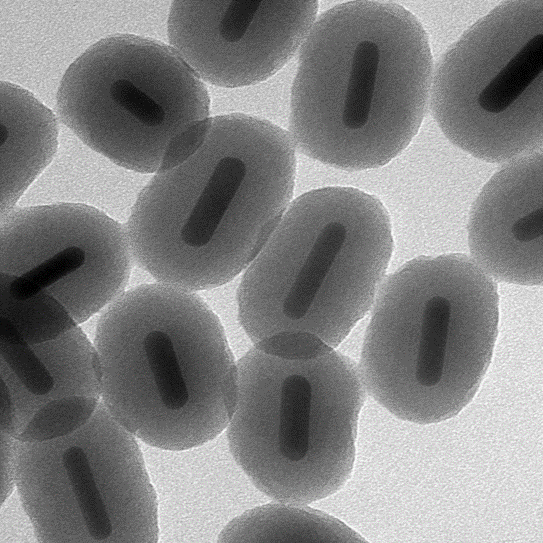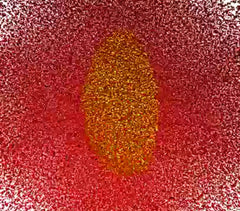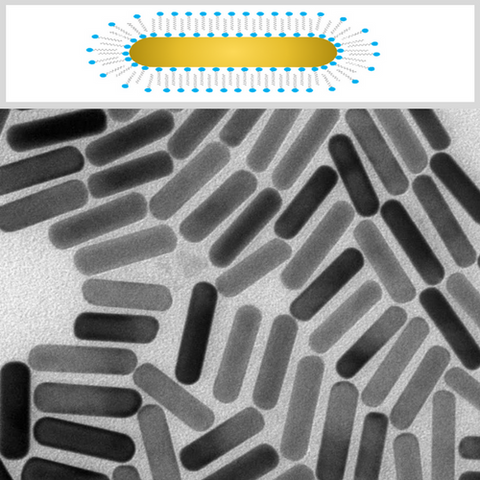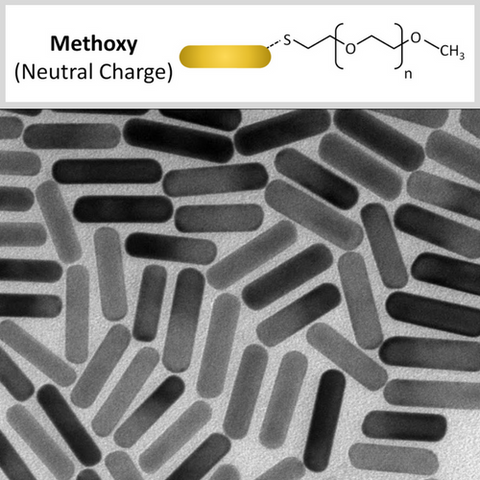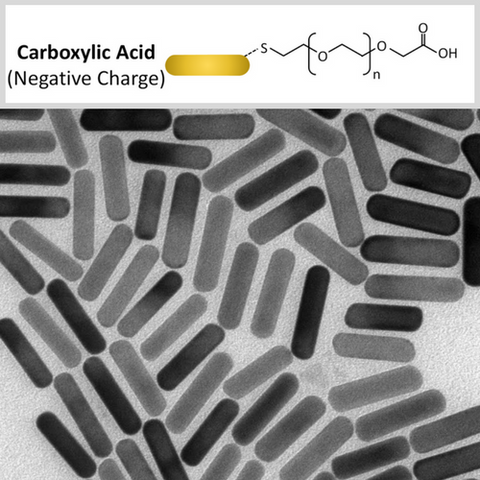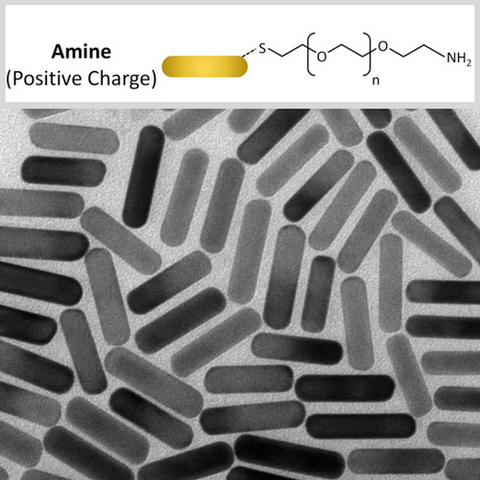Silica-Coated Gold NanoRods are optimized for applications such as Photoacoustic Imaging that require laser irradiation. Uncoated gold nanoparticles absorb pulsed-laser light energy and melt; changing the optical properties and destroying imaging signal. Most often, this nanorod shape change shifts absorption and scattering from near infrared (NIR) wavelengths to the visible spectrum1. For photoacoustic imaging and other applications where contrast requires near infrared light absorption, silica-coating is critical to produce reliable results.
Thermodynamic Instability of Uncoated Gold NanoRods

Click To Watch: video of an uncoated gold nanorod melting
NanoHybrids Silica-Coating
NanoHybrids' silica shell provides efficient, uniform heat transfer from the nanoparticles to the surrounding medium, thus enhancing thermodynamic stability and preventing melting2,3. Silica-Coated Gold NanoRods are available in 2 distinct variations: Hydroxyl Terminated & PEGylated

Silica coating of gold nanoparticles is accomplished using the classic Stöber method involving tetraethyl orthosilicate (TEOS) to form a highly branched and mesoporous siloxane polymer (termed silica) on the surface of gold. The standard silica thickness is 20 nm. However, the reaction can be controlled via reagent concentration and time to tailor the silica thickness. Contact us to discuss variations to the standard silica thickness.
Silica-Coated Gold NanoRod Features
- Optimized for photoacoustics and applications using near-infrared (NIR) light, available with 3 different aspect ratios / LSPR peak absorbances

all figures approximate within batch specifications
- Highly Monodisperse
- Leading Batch-to-Batch Consistency
- Low and High Concentrations*: OD = 1, OD = 100
- Silica shell thickness: 20 +/- 2 nm
- Dispersed in deionized and ultrafiltrated water (DIUF) (18.1 MW-cm)
- PEGylated product option uses 10 kDA PEG
- Batch-specific characterization including size, concentration, TEM images, and extinction spectra provided with every shipment
* OD = Optical Density as measured using a spectrophotometer using a 1 cm pathlength cuvette
For additional technical information click below to view detailed product data sheet
Photoacoustic Imaging Contrast Agents
When used as contrast agents in photoacoustic imaging (optoacoustic imaging), gold nanorods absorb light from a pulsed laser and generate substantial heat. Silica coating lowers the interfacial thermal resistance between gold and the surrounding solvent, allowing the particle to release more heat to its environment which has two positive effects:
(1) gold particles can resist melting at high fluences
(2) photoacoustic signal is >3X that of gold nanoparticles with standard coatings such as PEG, CTAB, or other polymers4.
 NanoHybrids Silica-Coated Gold NanoRods are specially tuned to maximize absorbance in the NIR, and we have partnered with leading Photoacoustic Imaging device manufactures to ensure our Silica-Coated Gold NanoRods deliver the best molecular signals with high resolution in real time. For more information on the advantages of silica-coated gold as photoacoustic contrast agents visit our page: benefits-of-silica-coated-gold-nanorods
NanoHybrids Silica-Coated Gold NanoRods are specially tuned to maximize absorbance in the NIR, and we have partnered with leading Photoacoustic Imaging device manufactures to ensure our Silica-Coated Gold NanoRods deliver the best molecular signals with high resolution in real time. For more information on the advantages of silica-coated gold as photoacoustic contrast agents visit our page: benefits-of-silica-coated-gold-nanorods
Additional Silica-Coating Benefits and Applications

Gold is NanoHybrids expertise and passion. Unlike other companies that offer a wide range of nanomaterials, NanoHybrids is selectively focused on producing the highest quality and best performing Gold Nanoparticles. Born from academic research laboratories, NanoHybrids offers innovative services and products tailored to preclinical research, like Silica-Coated gold nanoparticles. In addition to photoacoustics, other applications for which Silica-Coated Gold NanoRods have significant benefit include:
Other Resources
 Need concentration in different units than OD? Click the concentration chart to convert to mg/ml, M, or particle/ml.
Need concentration in different units than OD? Click the concentration chart to convert to mg/ml, M, or particle/ml.
Can't find what you are looking for? Fill out our custom nanoparticle request form and we will get back to you same day.
Questions? See answers to FAQs. Still have a questions? Send us a message.
See the NanoHybrids Difference

Cited References
1) Zijlstra, P. et.al. Five-dimensional optical recording mediated by surface plasmons in gold nanorods. Nature 459, 410-413 (2009).
2) Chen, Y.S. et al. Enhanced thermal stability of silica-coated gold nanorods for photoacoustic imaging and image-guided therapy. Opt Express18, 8867-8878 (2010).
3) Luke, G.P. et al. Silica-coated gold nanoplates as stable photoacoustic contrast agents for sentinel lymph node imaging. Nanotechnology 24, 455101 (2013).
4) Chen, Y.S. et al. Silica-coated gold nanorods as photoacoustic signal nanoamplifiers. Nano Lett. 11, 348-354 (2011).
5) Joshi P.P. et.al. Development and optimization of near-IR contrast agents for immune cell tracking. Biomedical Optics Express, 4 (11), 2609-2618 (2013).
6) Monem, A.S. et.al. Mesoporous silica coated gold nanorods loaded doxorubicin for combined chemo–photothermal therapy. International Journal of Pharmaceutics, 470(1-2), 1-7 (2014).
7) Bayer, C.L. et.al. Multiplex photoacoustic molecular imaging using targeted silica-coated gold nanorods. Biomedical Optics Express, 2(7), 1828–1835 (2011).
8) Luo, T. et.al. Mesoporous silica-coated gold nanorods with embedded indocyanine green for dual mode X-ray CT and NIR fluorescence imaging. Optics Express, 19 (18), 17030-17039 (2011).
9) Doering, W.E. et. al. Spectroscopic tags using dye-embedded nanoparticles and surface-enhanced Raman scattering. Analytical Chemistry, 75(22), 6171–6176 (2003).
10) Chen N.T. et.al. Enhanced Plasmonic Resonance Energy Transfer in Mesoporous Silica-Encased Gold Nanorod for Two-Photon-Activated Photodynamic Therapy. Theranostics. 4(8), 798-807 (2014).
11) Xia, F. et. al. Colorimetric detection of DNA, small molecules, proteins, and ions using unmodified gold nanoparticles and conjugated polyelectrolytes. Proceedings of the National Academy of Sciences, 107(24), 10837-10841(2010).
12) Son, M. et.al. Light-treated silica-coated gold nanorods having highly enhanced catalytic performances and reusability. Journal of Molecular Catalysis A: Chemical, 385, 38–45 (2014).

